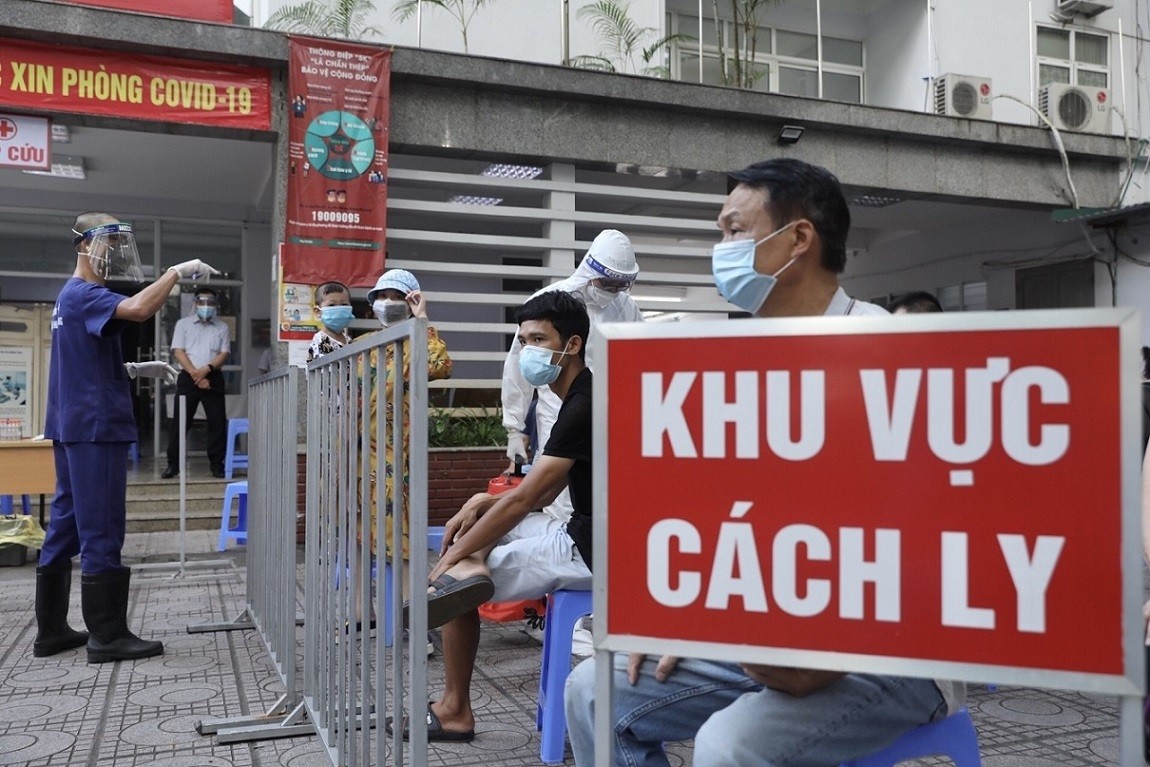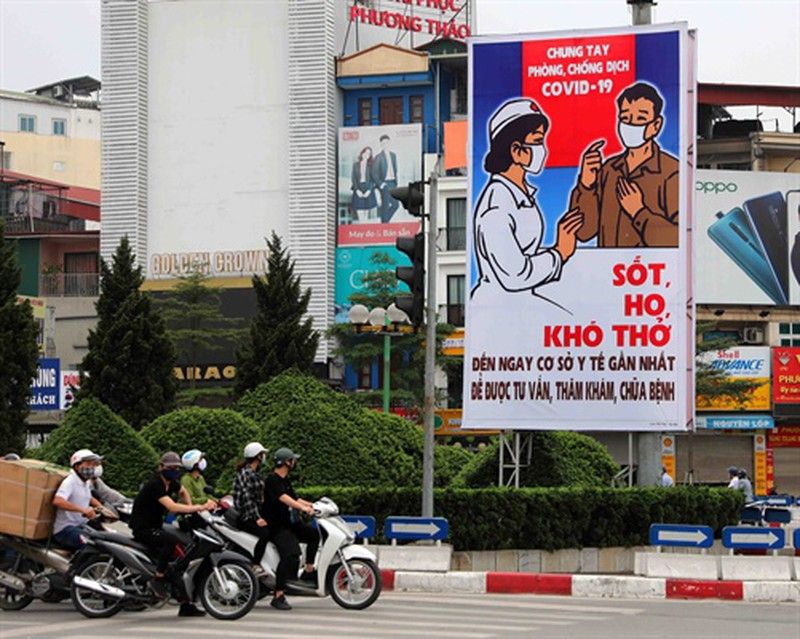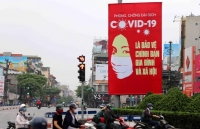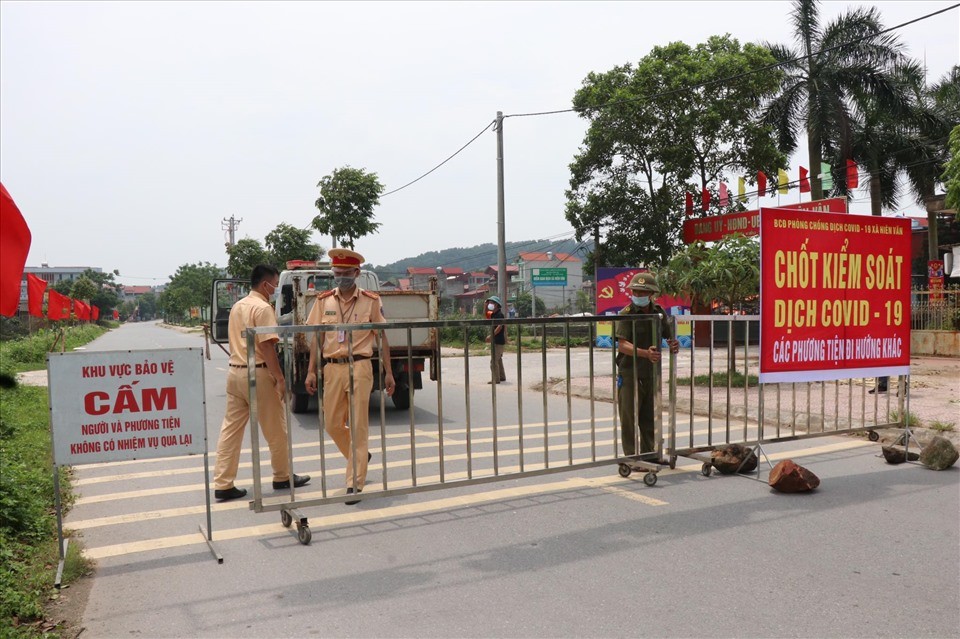
Vietnam is being seen as a model for other nations to emulate amid Covid-19
Latest
| TIN LIÊN QUAN | |
| Indian scholar lauds Vietnam's efforts in containing COVID-19 pandemic | |
 |
| Vietnam’s motto, the key for fighting Covid-19, remained “prevention is better than cure”. |
How did Vietnam do it? When the Covid-19 threatened to snowball with concomitant adverse consequences for the entire country, Vietnam’s motto, the key for fighting Covid-19, remained “prevention is better than cure”. The three early combined measures that it took and worked successfully are mass testing, tracing down suspected individuals and quickly isolating them. Other measures included social distancing order, body temperature checks of those arriving from overseas and numerous public communication campaigns to encourage citizens to follow preventive measures strictly.
Can Vietnam offer world any lessons on containment strategy?
After its early success, Vietnam joined Greece, Slovenia, Jordan and Iceland in being officially recognised internationally as one of the five countries for both “flattening the curve” in terms of severely reducing Covid-19 cases, and also succeeding in treating patients, with the majority of cases enjoying a full recovery and successfully being reintegrated back into the community. As a result of its success, Vietnam ordered schools to reopen, businesses to resume operation and people going back to living their normal life.
The common measures these five countries – three in Europe, one in West Asia and one on Southeast Asia – took to stem the virus’s spread included imposing lockdowns, testing thousands, and isolating the sick, encouraging social distancing and use of masks. As a result of these early measures, the five countries returned to normalcy in quick time.
Vietnam is a densely populated country that shares a 1,281 kilometre border with China, where the outbreak first began. Travel across border is relatively easy for the people of both China and Vietnam. Obviously it was feared that Vietnam would be vulnerable to virus outbreak as was China where it broke out in Wuhan. Vietnam showed great awareness of the danger posed by the spread of the virus and took timely steps to check its further spread. In fact, Vietnam’s timely action preceded World Health Organisation’s (WHO) declaration of the outbreak as a Public Health Emergency of International Concern. Its timely action contributed to the country reporting no Covid-19 deaths.
Without losing much time, Vietnam began testing soon after three people who had returned from Wuhan were confirmed to be carrying the deadly virus. So far approximately 300,000 people have been tested. Those tested were people arriving from areas hit by the Covid-19 and other epicentres, in addition to those who had contact with suspected cases, and those displaying symptoms of the virus. It is yet to confirm a single death from the disease. Vietnam had issued guidelines in December 2019 itself when it heard about the situation in China.
With a high density of population Vietnam has a weak health care system and a low budget for combating the Covid-19 but it is amazing that even when the pandemic rages in wealthy European countries more than 10,000 kilometres from China, Vietnam has largely been spared. How did Vietnam win the war by keeping its Covid-19 infection rate low? At the time of writing this (18 May 2020), Vietnam reported 320 infections (260 recovered) and no death since the outbreak began in January 2020. When the virus was still confined to China and had not even reached Vietnam, Vietnamese government ‘declared war’ on the Covid-19. Prime Minister Nguyen Xuan Phuc declared “fighting this epidemic, means fighting the enemy”.6
However, as mentioned earlier, Vietnam has some shortcomings such as inadequate government funding and not a very robust public health system. Vietnam does not have enough capacity to undertake a South Korea-style fight against Covid-19. The country’s medical system’s capacities are also limited. For example, the commercial city of Ho Chi Minh City with 8 million people has a total of 900 intensive care beds in the hospital. An epidemic if it spreads will easily overwhelm this capacity.
In order to overcome such deficiencies, Vietnam instituted rigorous quarantine policies, and carried out complete tracing of all people who came in contact with the virus. Vietnam was a step ahead of China in implementing such measures and did not resort to lockdown of entire cities like China as a last resort to keep the virus from spreading further. Unlike in many European countries, Vietnam put an entire town near Hanoi under quarantine for three weeks on 12 February even when there were only 10 confirmed Covid-19 cases in the entire country. Further, documentation of people who came in contact with affected people was meticulously made. In contrast, Western countries only documented those infected and their direct contacts. Vietnam also kept track of second, third and fourth levels of contacts of infected persons, all of whom were then placed under successively stringent levels of movement and contact restrictions. Added to this was anyone arriving in Vietnam from a high-risk area was quarantined for 14 days. All schools and universities were closed since the beginning of February.
Vietnam’s surveillance state system also helped. Despite shortcomings in medical system’s capacities and technology, Vietnam used its robust state security apparatus for widespread public surveillance. The state was also backed by a generally respected military. The close surveillance by the state machinery kept a tab on anyone from slipping through the net or evading regulations.
There was a downside of this as well. As is the case in many countries, including that in India as well, the nature of the virus is such that there is a sense of fear among the general populace. Unfortunately, this sense of fear has been stretched a bit too far to the extent of those falling victims of Covid-19 are ostracised in the community and on social media. Also, seen differently, the fear of social ostracism of those falling sick automatically put pressure on them to submit to government regulations. Prime Minister Phuc kept on reminding the people that “every business, every citizen, every residential area must be a fortress to prevent the epidemic”. Such war-like rhetoric was well received by the people, proud of their ability to stand together in a crisis and endure hardships. The role of the state-controlled media in undertaking massive information campaign cannot be underestimated either.
The people of Vietnam who take pride about their nationalism and feel supremely confident of their ability to fight any adversary in order to defend the country fully cooperated with the government in following measures in a war-like mode. This can be demonstrated from the fact that the country fared comparatively well in meeting the crisis. The limited number of critics who used to accuse the Communist Party of violating civil rights became admirers of the government measures even if those meant stricter control of the media. The economic costs despite the low number of cases would nevertheless be heavy but the people are seen to have accepted the hardship as the battle to defeat the virus has to be won.
The government was not afraid even if it meant closing down 3,000 businesses in the first two months of 2020. Big conglomerates like the Vin Group shuttered dozens of hotels and resorts due to the drop in tourism, costing employees their jobs. To ease the burden, the government made available $1.1 billion to pump liquidity into the economy. However, it is feared that tax revenues could dry up because of the crisis. The government has called for voluntary donations and people are responding positively so that the government can cope with the crisis and fight against Covid-19.
Import Dimension of Covid-19
Sharing a long border with China, Vietnam was not immune from the issue of imported Covid-19 cases. Though the government responded quickly with measures to contain the virus from spreading, the economy took a hit. Out of the more than 30,000 people Vietnam tested, 37 foreigners and 136 Vietnamese were infected with Covid-19. Several big cities like Hanoi, Da Nang and Hai Phong saw confirmed cases of new infections.
Fearing that Vietnamese returning from overseas and other foreigners arriving in Vietnam could be potential carriers of the virus, overseas Vietnamese were advised to reconsider their return plan for the sake and benefit of the nation. However, when new cases were found, they were Vietnamese expatriates returning home to avoid Covid-19 outbreak spreading in the UK, Italy and the US. The biggest city in the country, Ho Chi Minh City that saw most infected cases had origins from people returning from overseas. The local authorities were forced to order closing all bars, restaurants, and entertainment centres until the end of March.
On 22 March, Prime Minister Phuc ordered relevant authorities to suspend entry for foreign nationals entering to the country, including those of Vietnamese origin and family members with visa waivers. Even when they did enter the country, they were required to fulfil health declaration and follow 14-day quarantine procedure. Foreign experts, business managers, high-skilled workers carrying official documents endorsing their travel plans, and approved by the Vietnamese government, were allowed to enter the country but were isolated at their accommodation establishments. Prime Minister Phuc also ordered the suspension of all international flights coming to Vietnam, without giving a specific time frame. Entry to the country was also restricted by air, road and sea.
The government made a list of overseas Vietnamese and students who needed to return home and organise flights for them. The overseas embassies were advised that they should recommend Vietnamese living abroad not to “return home if it is not really necessary”. But Phuc was emphatic: “All people who enter Vietnam must be strictly quarantined and violators will be heavily punished”. Vietnam suspended visas for all foreign arrivals and all those arrived were put in quarantine for two weeks. Phuc also urged the people to increase online transactions, use more phones at work and less direct communication to avoid risk of infection. He appealed believers to pray and practice religious matters at home and asked not to hold wedding anniversaries and crowded parties to deal with every aspect of life like it was wartime. National flag carrier Vietnam Airlines announced suspension of all its international flights from 25 March. While budget airline Vietjet Air suspended all flights to China and South Korea and halted flights to Southeast Asian countries, it continued to operate flights to India, Taiwan and Japan. All non-essential businesses were shut and restrictions on movement were imposed.
Vietnamese people were willing to make the sacrifices for greater goal. Self sacrifice by some Vietnamese soldiers offering bed spaces at arrivals at military-run quarantine centre became talking point of peoples’ sacrifice and depth of cooperation for national interests. One can see a sense of national pride among the Vietnamese people to keep the Covid-19 under control from spiking. Vietnam’s political leadership in the country’s robust response was indeed commendable. So far, the efforts have been successful and there is not a single case of death because of Covid-19. But the country needs to stay on alert for more time.
Like in India, public donation poured in Vietnam to support the government in fighting the pandemic. For example, Nestle Vietnam, a nutrition, health and wellness company, donated 12 billion VND ($ 515,129). Peoples were encouraged to pursue a healthy lifestyle and join hands to overcome the pandemic. In coordination with La Vie company, a subsidiary of Nestle Group, the firm implemented a wide range of activities to support doctors, nurses, public security and military forces, and volunteers who are in the front line of the battle against the disease. It also provided food, nutrition drinks, and cash, besides close to 300,000 relief packages and medical face masks to be sent to hospitals, health centres, functional forces and volunteers in some localities nationwide.
Praise for Low-cost Model
The success achieved with limited resources focusing on quarantine and contact tracing received international praise. With a determined leadership, it began to be seen as a model in containing the disease. South Korea embarked on mass testing because it could afford to invest resources in its disposal. On the other hand, Vietnam focused on isolating infected people and tracking down their second and third-hand contacts. Besides aggressive tracing of infected people’s contacts, Vietnam’s measures also included forced quarantines and the conscription of medical students, retired doctors and nurses to join the fight.
Carl Thayer, professor emeritus at the University of New South Wales, Canberra, observes: “Vietnam is a mobilisation society. It is a one-party state; it has large public security forces, the military and the party itself; and it’s a top-down government that’s good at responding to natural disasters.” Even with the “second wave” of infections traced to people arriving from abroad, Vietnam saw not even a single death. As of 20 March, Vietnam had tested 15,637 people, a fraction of the 338,000 tested in South Korea. Though the true number of cases in other countries in Southeast Asia could be much higher than reported because of limited testing, Vietnam’s response stands out in containing the virus from spiking. Vietnam was the first country after China to seal off a large residential area as early as on 13 February and imposed a 21-day quarantine in a part of Vinh Phuc province, north of Hanoi, where more than 10,000 people live. Vietnamese workers returning from Wuhan were found to be infected.
Vietnam’s response was praised by the World Health Organisation’s representative in Hanoi, Kidong Park, who lauded Vietnam for its “pro-activeness and consistency throughout the response”. Whether Vietnamese model based on mobilisation of medical and military personnel, surveillance and intrusion and the state’s network of informants that gave it success would be suitable for the US or European countries is doubtful. The South Korean model could be more suitable for Europe and the US than that of Vietnam.
In any such case of gigantic proportion of government initiative to address the issue, the cooperation of the citizen is indispensable. The way a small nation dealt with the challenges with limited resources received international praise. The citizens understood the gravity of the problem early on and cooperated with the government in implementing the measures, an example worth-emulating by other countries in Europe and the US. Here, some lessons can be learnt by India as well. Despite that the government in India took timely action such as lockouts, some deficiencies remained. That was natural because of the huge size of the population and large geographical reach. The issue of migrant labour returning to their homes far away during the lockdown period posed enormous challenge to the government. Yet, some small section of the educated segment of the population did not fully cooperate with the government. Vietnam’s example is worth-emulating for them since the challenge is not over yet. It is hoped that Prime Minister Modi’s exhortation that carelessness and ill-conceived notion of a few such as the case of Tablighi Jamaat could put the entire country in jeopardy is best understood in all seriousness.
Vietnam’s Extends Help to Others
As a responsible nation with cooperative federalism as the new slogan in the contemporary world, Vietnam was a willing partner to extend help and cooperation to fight this global menace. Within its own capacity, Vietnam shared information and experience, and provided medical supplies and equipment to other countries despite its own constraints. On 8 April Prime Minister Phuc reaffirmed Vietnam’s commitment in a message to the virtual conference of Health Ministers of the WHO Western Pacific Region themed “Stand in Solidarity to combat Covid-19”. Being the ASEAN Chair for 2020, Vietnam realises its added responsibility to extend cooperation to other countries in fighting the Covid-19. In a statement, Vietnam also called for concerted actions in cooperation with fellow member states to fight against Covid-19. Prime Minister Phuc suggested the WHO to continue taking the lead in mobilising and coordinating efforts, particularly in developing vaccine, treatment drugs, providing medical supplies and equipment.
On 8 May, Deputy Foreign Minister Le Hoai Trung handed over the token of the 140,000 medical face masks from the Vietnamese government to their counterparts in Japan. This was in accordance with the agreement reached between Prime Ministers Phuc and Abe Shinzo of Japan during their phone talks on 4 May. Both Japan and Vietnam being strategic partners, sharing information and cooperating closely in fighting Covid-19 within both bilateral and multilateral frameworks, including ASEAN+3 speaks of both being responsible stakeholders in the region. Trung also extended appreciation of Japanese government for supporting and assisting Vietnamese community in Japan in this time of crisis. Japanese ambassador in Vietnam remarked Vietnam being a model in preventing and controlling the disease.
Similarly, Farmacia Orient, a Vietnamese-owned company presented 600 Made-in-Germany Covid-19 test kits to the National Public Health Agency of Moldova. As of May 2020, in the eastern European country of 3 million, more than 300,000 people were infected with Covid-19. Preventive measures applied by the Moldovan government, especially quarantine solutions, proved effective, and the Vietnamese firm’s practical support helped reinforce local trust in winning the fight against Covid-19.
As one of the closest partners in the ASEAN grouping, Vietnam has a special space in India’s strategic calculus. No wonder, at this critical time Prime Minister Modi had a telephone conversation with his Vietnamese counterpart, as with several other leaders of friendly countries, and discussed the situation arising out of the Covid-19 pandemic and the steps being taken to address the challenge. Both leaders agreed on the potential for bilateral cooperation in fighting Covid-19, including for facilitating supplies of required medical equipment, besides committing to provide necessary support to each other’s citizens present in their territories. They also reviewed regional and international developments.
* Professor Rajaram Panda is Lok Sabha Research Fellow, Parliament of India and Member, Governing Council of Indian Council of World Affairs, and Centre for Security and Strategic Studies, both in New Delhi.
The article expresses his own views.

| GAVI lauds Vietnam’s four ways to control COVID-19 |

















